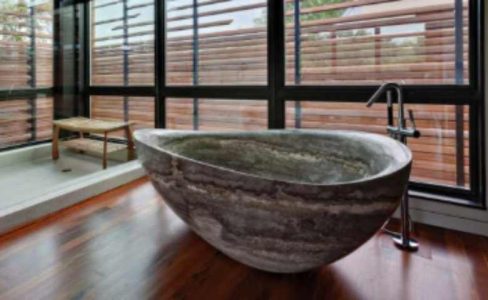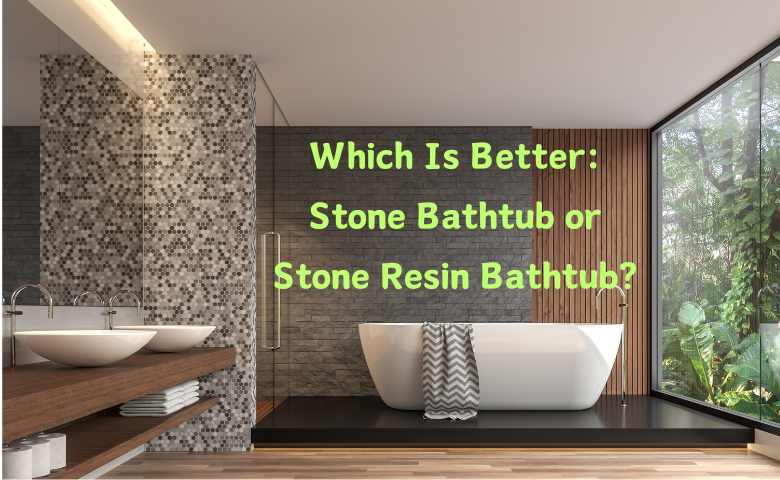Last Updated on April 29, 2025 by Admin
In modern home design, bathtubs have long surpassed their simple bathing function to become an important element in enhancing quality of life and elevating spatial aesthetics. However, when faced with the dazzling variety of bathtub materials on the market, many homeowners often feel confused — particularly when it comes to choosing between a “stone bathtub” and a “stone resin bathtub,” two options that seem similar but are actually very different. This confusion often stems from a lack of understanding of the true nature of the materials, or from being misled by marketing jargon.
We understand that selecting the right bathtub involves considering multiple factors, such as material characteristics, user experience, and maintenance costs. This article will dive deep into the fundamental differences between these two types of bathtubs, objectively compare their pros and cons, and help you find the perfect balance between luxurious bathing experience and practical functionality, ultimately guiding you toward the best choice for your personal needs.
Fundamental Differences Between Stone Bathtubs and Stone Resin Bathtubs
As the name suggests, a stone bathtub is carved from a single block of natural stone, commonly using materials such as marble, granite, or travertine. These bathtubs embody the craftsmanship of nature itself — every vein and texture within the stone is a testament to geological evolution, telling a unique natural story. Skilled artisans sculpt these hard stones into smooth curves, preserving the original texture and color of the material.
The most captivating feature of a stone bathtub lies in its inimitable natural beauty — much like a fingerprint, no two stone bathtubs are exactly alike. As your fingers trace the subtle natural textures, it feels almost as if you are touching the accumulation of centuries of history.

On the other hand, stone resin bathtubs represent a modern triumph of materials science, blending the essence of nature and human innovation. Typically composed of up to 80% natural stone powder and 20% high-performance resin (with variations depending on manufacturing processes and brands), this material is created through precise blending and vacuum-casting techniques to form ideal shapes. The stone powder, often derived from marble or quartz processing leftovers, is finely ground and uniformly mixed with eco-friendly resin before being molded and cured into shape.
This process grants stone resin bathtubs remarkable design flexibility, allowing for thin edges and complex curves that traditional stone materials struggle to achieve.

The most fundamental difference between the two lies in their creation process: one is a natural masterpiece refined through subtractive sculpting, while the other is a man-made innovation crafted through additive synthesis.
A natural stone bathtub carries an innate noble character and subtle imperfections — much like an aristocrat weathered by time. In contrast, a stone resin bathtub is like a carefully nurtured artist, retaining the essence of nature while embodying the precision and controllability of modern technology.
Pros and Cons of Stone Bathtubs and Stone Resin Bathtubs
When standing at the crossroads of choice, understanding the real-world performance of these two types of bathtubs is crucial.
Stone bathtubs proudly offer their naturally luxurious appeal; under lighting, the organic patterns create breathtaking plays of light and shadow, bringing an unmatched artistic atmosphere to the bathroom. High-quality marble bathtubs gradually develop a warm patina with use, similar to how antique furniture gains character over time.
In terms of heat retention, the dense stone material excels, keeping bathwater warmer for longer — perfect for those who love extended soaking sessions.
However, this gift from nature comes at a price: the porous nature of stone makes it prone to absorbing moisture and stains, requiring regular professional sealing. Its substantial weight not only complicates transportation and installation but also places significant stress on building structures. Furthermore, natural stone’s brittleness makes it susceptible to cracking upon impact. Combined with the high costs of quarrying and craftsmanship, stone bathtubs are often priced several times higher than standard bathtubs.
In comparison, stone resin bathtubs strike a delightful balance. Visually, advanced manufacturing techniques can closely replicate the appearance of luxurious stones, with some high-end models achieving near-indistinguishable realism.
Some brands employ proprietary surface treatment technologies, preserving the matte texture of stone while creating a completely non-porous, dense structure — eliminating the risks of water seepage and mold growth.
The material’s flexibility greatly enhances impact resistance, meaning accidental drops of heavy objects are less likely to cause damage. Stone resin bathtubs also weigh only about one-third of their natural stone counterparts, significantly simplifying installation.
Moreover, the thermal conductivity of stone resin has been carefully engineered: it doesn’t conduct heat away as quickly as metal does, nor does it initially feel as cold as pure stone — instead offering a pleasantly warm touch.

Maintenance is easier too; gentle cleansers are sufficient to keep it looking new, eliminating the need for regular sealing.
The difference in user experience is equally worth noting. Stone bathtubs feel cold and hard upon initial contact, requiring some adjustment, though they gradually warm up to a comfortable temperature with the bathwater.
Stone resin bathtubs maintain a consistently warm and smooth touch, making them particularly suitable for the elderly and children.
In terms of safety, the naturally slip-resistant surface of stone resin greatly reduces bathing risks, whereas most stone bathtubs require additional anti-slip mats.
For consumers seeking personalized designs, stone resin materials allow easy customization of colors and shapes — an advantage hard to achieve with natural stone.
Of course, if viewed purely as an investment, top-grade natural stone bathtubs retain better resale value. But when considering overall usage cost and practicality, stone resin bathtubs clearly offer a more sensible choice.
Conclusion
Bathing should be a feast for the senses, and the bathtub is the sacred centerpiece of that ritual.
When choosing between a stone bathtub and a stone resin bathtub, there is no absolute right answer — only the option that best suits your personal needs.
If you value the ultimate natural beauty and investment potential and are willing to commit to higher maintenance, a natural stone bathtub is truly a dream to own.
However, if you prioritize practical functionality, safety, comfort, and hassle-free maintenance, a stone resin bathtub is undoubtedly the wiser choice.
Source: Giving Tree Home
This article is brought to you by Giving Tree Home, a well-known name in the bathware industry, specializing in the design, production, and sale of stone resin bathtubs.
If you are considering purchasing a bathtub, Giving Tree Home is a great option to explore. In addition to stone resin bathtubs, they also offer a wide range of other bathroom products — from toilets to vanities, from showers to faucets, and many other small fixtures.
Moreover, if you need an entire bathroom solution, they are more than capable of meeting your needs.
Related Posts
- Transform Your Home: A Comprehensive Guide to Resin Driveways
- Should you Re-glaze or Replace your Bathtub During Renovation
- Furnace Maintenance 101: Tips for a Warm and Cozy Home
- Three Ways to Put a Shower Over Your Bath – and Tips for a Great Showering Experience
- The importance of Stone CNC Machine in Construction Sector


